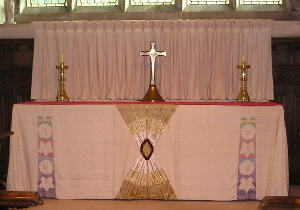The Lectern
The wooden eagle lectern, given as a memorial in 1975, was carved in lime wood by a Lewes craftsman (Martin Pierce) who later moved to Los Angeles.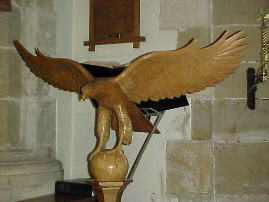
The Organ
The organ gallery at the west end of the Nave was built in the early 1930’s for the present organ as a gift from John Christie of Glyndebourne. Much of the panelling came from Glyndebourne and is thus a good deal older. In the past the choir has sung from this gallery, but at present they occupy the stalls in the chancel.The organ had a major refurbishment in the late 1980’s. In the Springett Chapel there is a book which records the names of those who sponsored pipes as part of the associated fundraising. In its present form, the instrument has three manuals and 45 speaking stops.
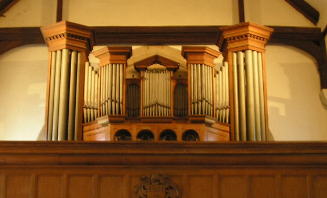
The Children's Worship Area
The Children's worship area was created in the Springett Chapel in 1999 as a millennium project. The mosaic panel behind the altar table is the work of Anne Clark, an artist and member of the congregation. The stools and other furnishings are the work of her grandson Daniel.The area is used regularly for "Toddlers' Time", a midweek mothers and toddlers service, and by the Saturday Club.
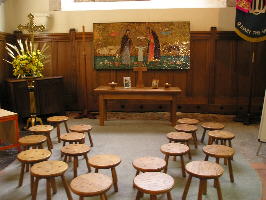
The Tower
The towers of St Mary's have quite a complex history, but the present tower was constructed in 1884. Like much of the church building it is faced in flint. The ground floor is used for vestries (vicar's, choir, and sidespersons') above which the organ occupies virtually the whole of the next floor. There is a ring of 8 bells (13 cwt 3 qrs in E) rung from a ringing room above the organ.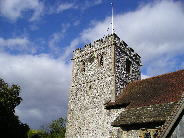
The Church Room
The Church Room was built in 1998-9 to provide a meeting room together with a kitchen and lavatories - these last having been long requested by members of the congregation. The room was designed by Peter Pritchett the church architect. Externally the materials used, flint walls with stone dressings, match the rest of the church building. The interior and fittings all display craftmanship of a high order - from the blacksmith-made curtain fittings to the tiles in the kitchen - and even the lavatories.The room has already found a wide variety of uses from the children's Sunday Club to series of "Church Room Talks".
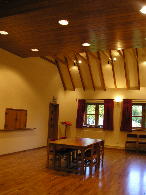
The Chancel
When the Chancel was first built there were narrow lancet windows behind the altar; the window you can see to the right the third; it replaced an early 19th century window in 1901. The glass shows Christ's Nativity with kings and shepherds in attendance. In the smaller lights, the Angel Gabriel announces to Mary that she will be Christ's mother and there are many lilies, the flower traditionally associated with the Virgin Mary, who is the patron saint of the Church. The emblem at the top of these pages is based on one of these.The choir stalls are Victorian; they were extended, and the third tier added on the south side, in the 1960's to accommodate the size of the choir at that time. The now somewhat smaller choir of men, women and children sing at two Sunday services.
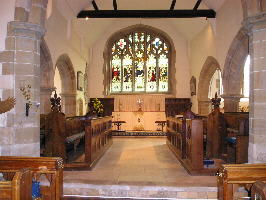
The Porch
The wooden porch outside the south door was built in the 15th century and it is possible that some of the original timbers remain. The statue of the Virgin Mary over the entrance is 20th century.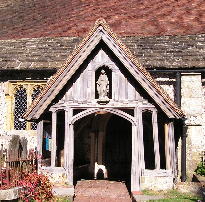
The Nave
The pillars of the nave are probably the oldest parts of the fabric. The nave together with its two side aisles can seat about 200 people. For services with very large congregations such as the midnight Eucharist at Christmas, Easter Sunday, or Rememmbrance Day, additional seating is arranged in the Springett and Lady Chapels.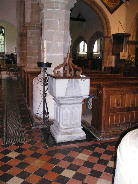
The Springett Chapel
The Springett Chapel on the south side of the chancel is known to have been built before 1527, because in his will John Thatcher of Broyle Place, who died in that year, said that he had ‘edifyed and builded’ it. It is named for the Springett family, both because it contains memorials to two 17th century members of that family and because it was restored by members of the family in 1921. The chandelier was designed for the Chapel as part of this restoration. The easterly part of the chapel now forms the children's worship area.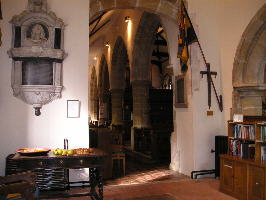
The Lady Chapel
The Lady Chapel is, unusually, on the north side of the Chancel; in very grand churches and cathedrals, the Lady Chapel is usually behind the high altar; in smaller churches, it is traditionally on the south side. Since the dedication of the whole Church is to the Virgin Mary, it is rather odd to have a chapel with the same dedication. Indeed there is some doubt as to whether it was ever dedicated in this way. The architecture of the Chapel is late perpendicular like that of the Springett Chapel opposite. We can date this building fairly accurately since, in his will of 1535, Robert A'Borowe of South Malling directs his executor to "sell up three houses in Lewys in the permanence of the Chapel I begun at Ringmer". The decoration of the plaster ceiling (right) features a vine with bunches of grapes. This recalls Christ's description of himself (John 15 v 1) as the 'the true vine'. The tracery of the windows in this Chapel appears to date to its original building.The chairs in this Chapel are recent and were all given in memory of people with close connections with Ringmer. Brass plates below the fronts of the seats record their names.
The Holy Sacrament is "reserved" in this chapel.
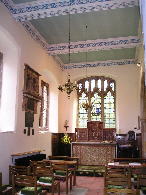
The Main Altar
The altar frontal has recently been designed and made by Marian Cantrell. It has a set of seasonal "antependia" - central panels that can be changed for the various seasons of the Church's year.The antependium in the picture is the "white" one for Christmas and Easter. The design incorporates the words "Gloria" and "Alleluia".
Click here for more details of the frontal etc.
